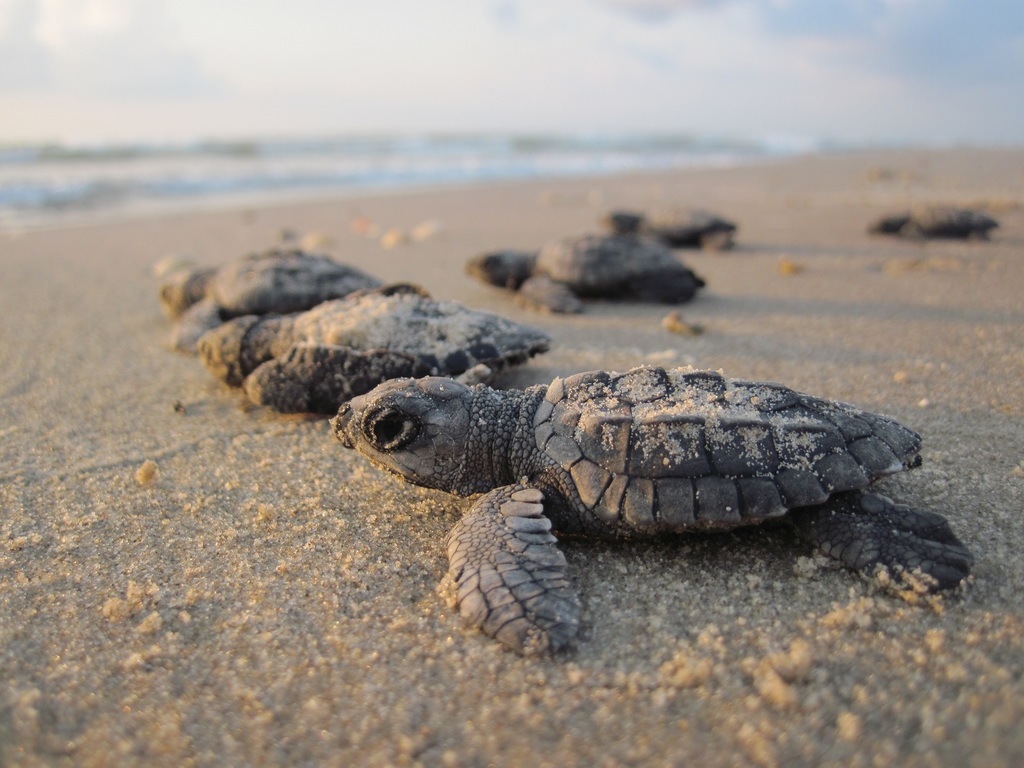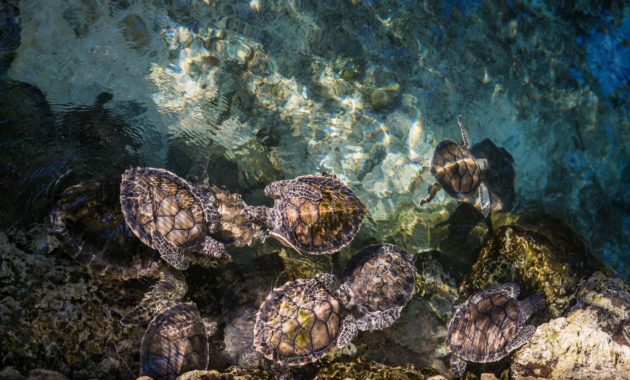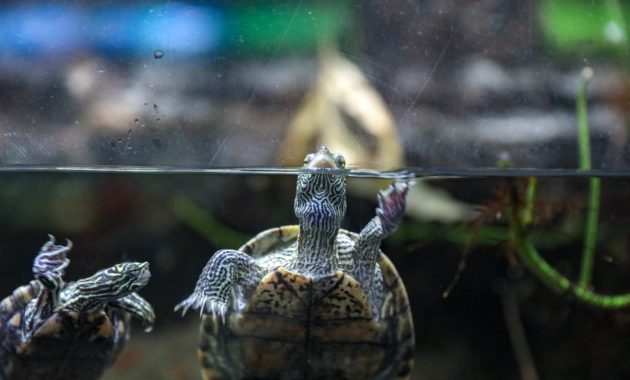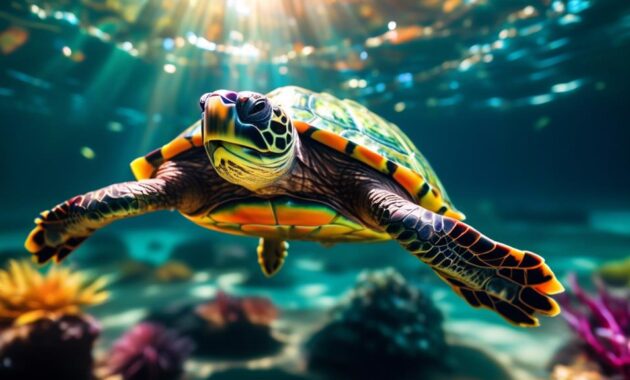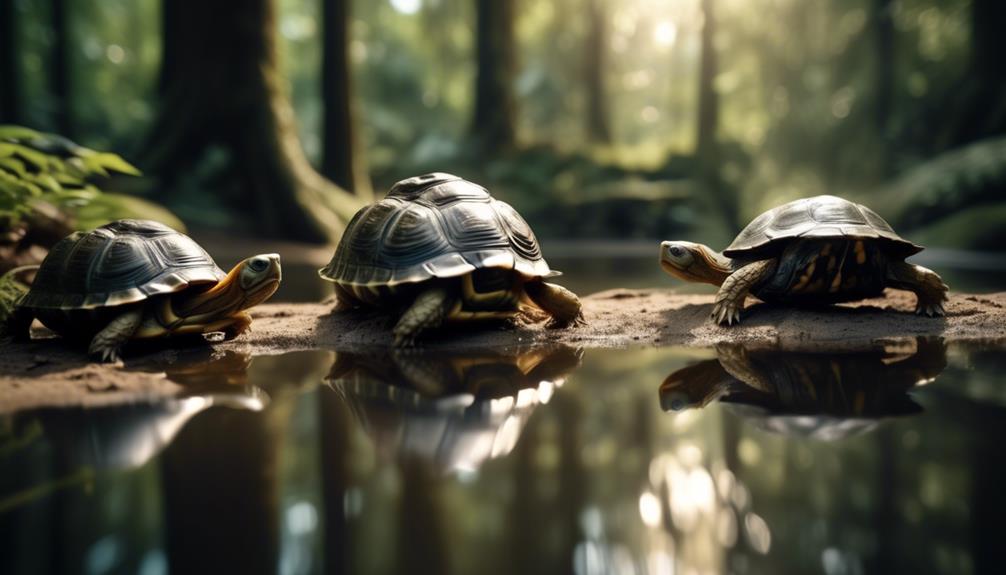
Are you ready to uncover the hidden mysteries of mud turtles?
Prepare yourself for a captivating journey into the fascinating world of these enigmatic creatures. From their elusive behaviors and unique characteristics to their mesmerizing appearance and intriguing habitats, there is so much to explore.
So, grab your sense of wonder and get ready to embark on a voyage that will leave you spellbound, as we unveil the secrets of mud turtles and unravel the mysteries that lie beneath the surface.
Key Takeaways
- Mud turtles are small in size and have an average lifespan of 50 years.
- Sexual dimorphism is a characteristic feature of mud turtles, with males being larger and having rough patches on their legs.
- Mud turtles have unique shell characteristics, with an oval-shaped shell and hinges on the plastron.
- They have special glands that release a foul-smelling fluid as a defense mechanism and for communication with other turtles.
Size and Lifespan of Mud Turtles
Mud turtles exhibit small size and have an average lifespan of 50 years. These turtles are known for their compact bodies, making them easily distinguishable from other turtle species. Despite their small size, mud turtles can live for several decades, making them long-lived creatures.
They’re comparable in size to Musk turtles, but males tend to be larger than females. Male mud turtles have a larger tail, legs, and head compared to their female counterparts. This sexual dimorphism is a characteristic feature of mud turtles.
With their small size and impressive lifespan, mud turtles are fascinating creatures that have adapted well to their environments.
Sexual Dimorphism in Mud Turtles
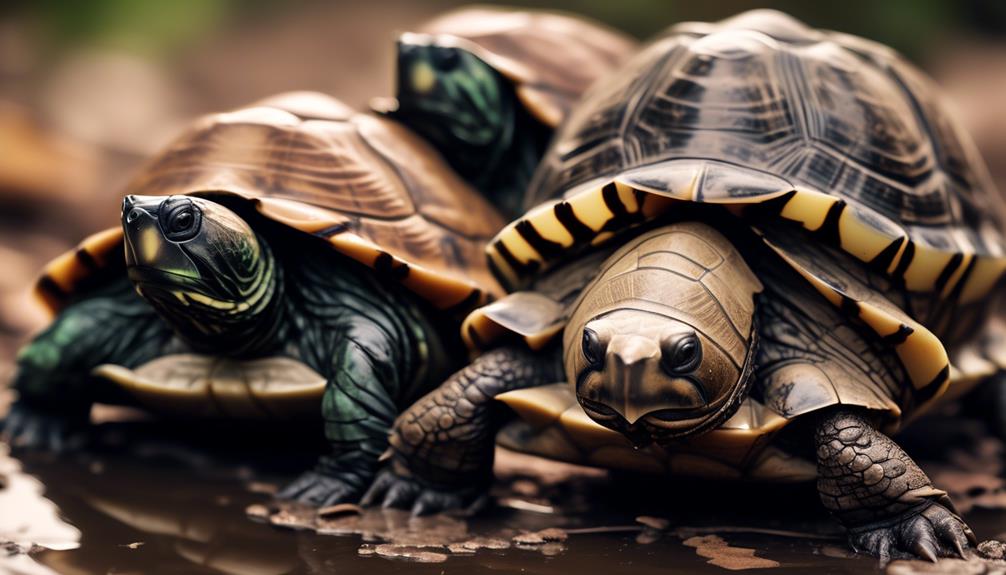
When it comes to mud turtles, one clear distinction between males and females is their size and physical features. Males are generally larger than females, with a larger tail, legs, and head. In addition to size, male mud turtles also have scaly, rough patches on the insides of their legs.
This sexual dimorphism is believed to be related to their reproductive behavior. During mating season, male mud turtles use their larger size and physical features to attract females and compete with other males for mates. Female mud turtles, on the other hand, tend to be smaller and have smoother legs.
Understanding these differences in size and physical features is crucial for accurately identifying the gender of mud turtles and studying their reproductive behavior.
Appearance of Mud Turtles
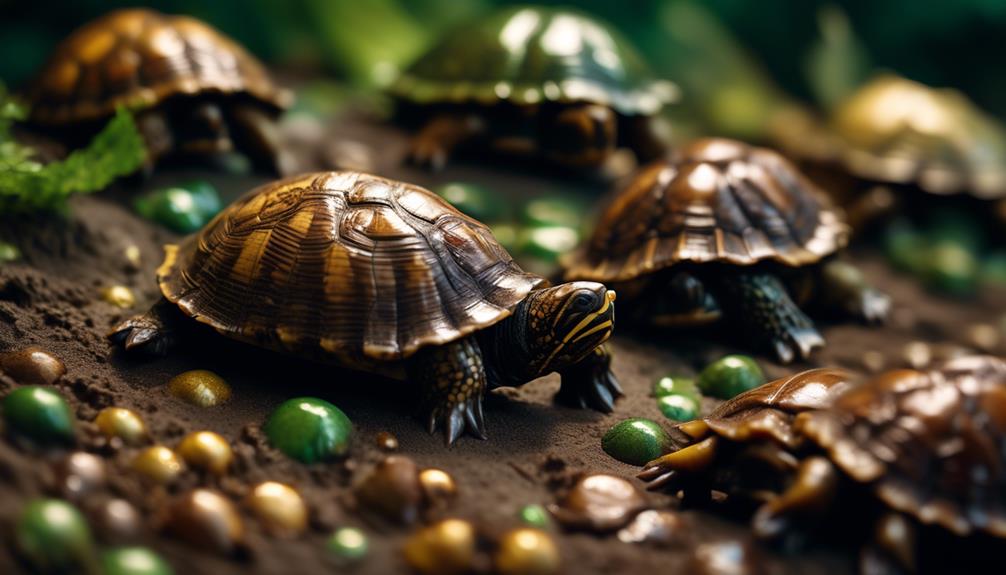
With an oval-shaped shell and one or two hinges on the plastron, Mud Turtles possess distinct physical characteristics that set them apart from other turtle species. Here are four fascinating features of their appearance:
- Glands on the sides of the body that release a foul-smelling fluid: These glands serve as a defense mechanism for Mud Turtles. When threatened, they can release a pungent odor that deters predators.
- Different species have variations in color and patterns: Mud Turtles come in a range of colors, from dark brown to olive green. Some species have intricate patterns on their shells, adding to their uniqueness.
- Male Mud Turtles have scaly, rough patches on the insides of their legs: These patches, known as tubercles, are used for courtship. They provide traction during mating, allowing the male to grip onto the female’s shell.
- Small in size with an average lifespan of 50 years: Mud Turtles are relatively small compared to other turtle species. Despite their size, they can live for several decades, making them intriguing creatures to study and observe.
Shell Characteristics of Mud Turtles
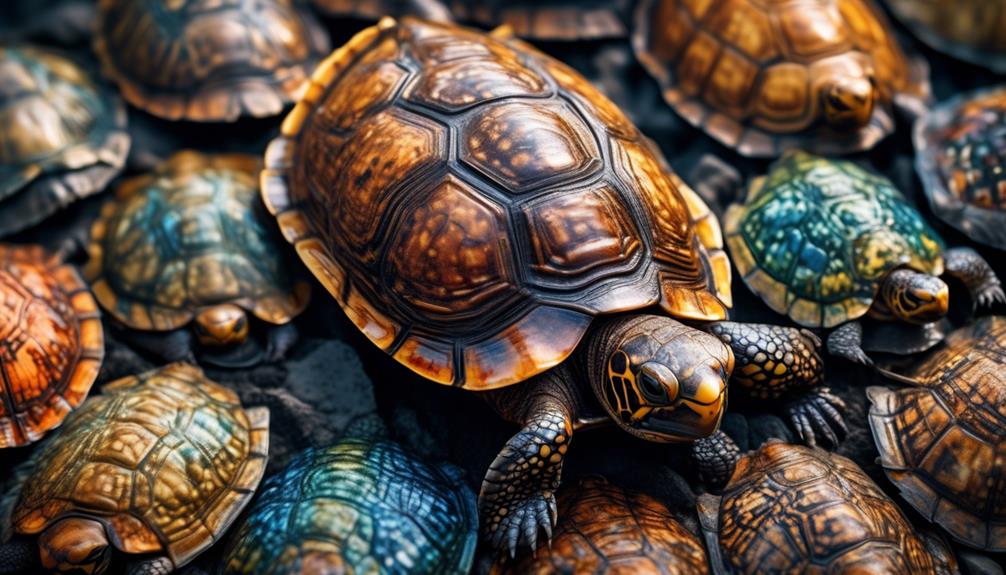
One distinguishing feature of Mud Turtles is their unique shell characteristics. Their shells are oval-shaped and may have one or two hinges on the plastron, which allows them to close their shell tightly for protection.
The shells of Mud Turtles also have scaly, rough patches on the insides of their legs, particularly in males. These rough patches help them grip onto their mates during mating season.
Additionally, the color and patterns of Mud Turtle shells can vary among different species. Some may have dark brown or black shells, while others may have lighter shades or even vibrant patterns.
These shell characteristics not only contribute to the overall appearance of Mud Turtles but also play a vital role in their survival and reproduction.
Glands and Secretions of Mud Turtles
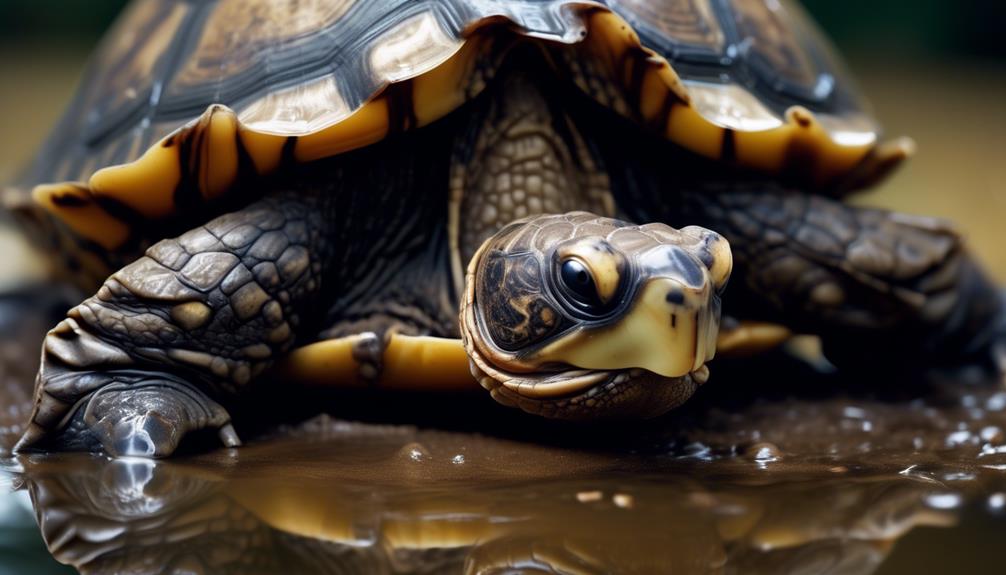
Now let’s explore the fascinating world of Mud Turtles by uncovering the secrets behind their unique glands and secretions.
These remarkable creatures possess special glands on the sides of their bodies that release a foul-smelling fluid. Here are four intriguing facts about the glands and secretions of Mud Turtles:
- Defense Mechanism: The foul-smelling fluid released by the glands serves as a defense mechanism against predators. This strong odor acts as a deterrent, making potential threats think twice before attacking.
- Communication Tool: Mud Turtles use their secretions to communicate with each other. By releasing specific scents, they can convey messages related to territory marking, mating rituals, and even warnings about potential dangers.
- Chemical Composition: The secretions of Mud Turtles contain a mixture of chemicals that vary among different species. These chemicals not only contribute to the strong odor but also play a role in attracting mates and defending their territories.
- Health Indicator: The quality and scent of the secretions can provide valuable information about the overall health of Mud Turtles. Any changes in the composition or intensity of the odor may indicate underlying health issues or stress.
Color and Pattern Variations in Mud Turtles
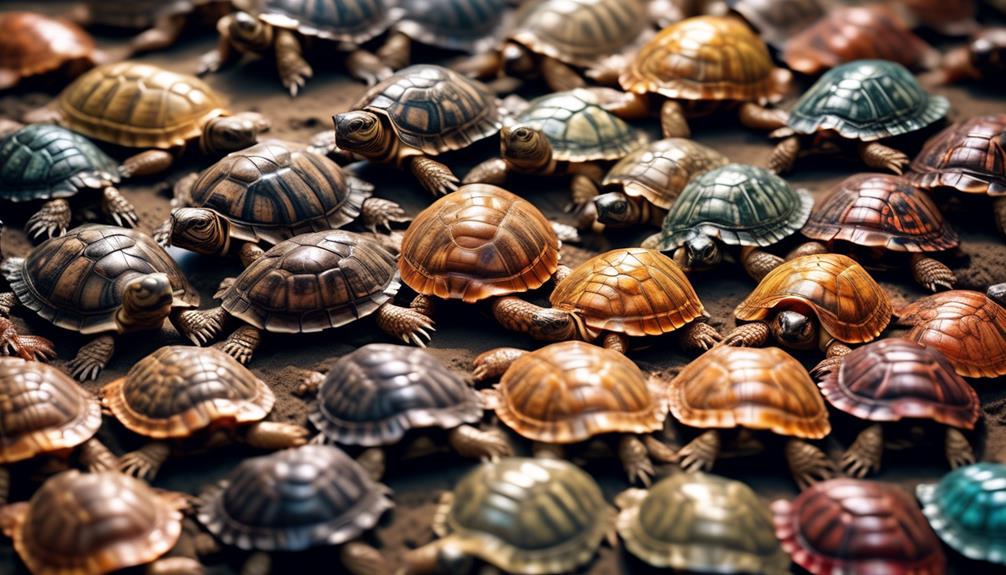
The color and pattern variations of Mud Turtles add to their captivating allure. These turtles exhibit a range of colors and patterns that make each individual unique. Here are some examples of the different color and pattern variations you may come across:
| Color | Pattern | Example |
|---|---|---|
| Brown | Speckled |  |
| Black | Striped |  |
| Olive | Spotted |  |
| Tan | Mottled |  |
These variations in color and pattern make Mud Turtles visually appealing. Whether you prefer the earthy tones of a brown speckled turtle or the striking contrast of a black striped turtle, there is a Mud Turtle for everyone. Keep in mind that the colors and patterns may vary depending on the species and individual characteristics. So, the next time you come across a Mud Turtle, take a moment to appreciate its unique color and pattern combination.
Male Mud Turtles: Unique Features
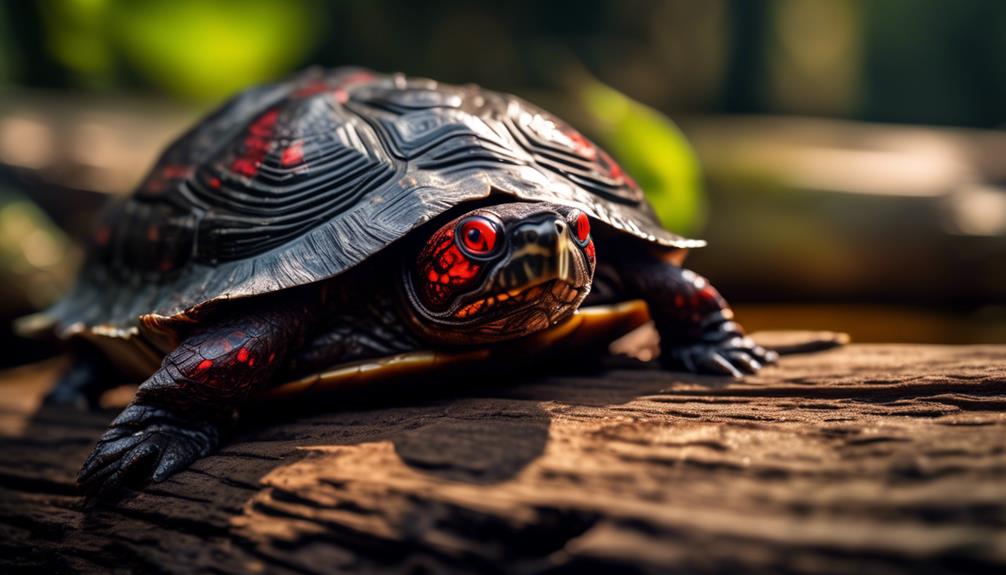
Male Mud Turtles possess distinct physical characteristics that set them apart from their female counterparts. These unique features are sure to capture your attention and leave you in awe:
- Larger size: Males are generally larger than females, boasting an impressive stature that demands respect.
- Bulky tail, legs, and head: Their tail, legs, and head are noticeably larger and more robust, giving them a powerful and commanding appearance.
- Scaly, rough patches: Male Mud Turtles have scaly, rough patches on the insides of their legs, adding to their rugged charm.
- Confident presence: With their striking physical attributes, male Mud Turtles exude confidence and dominance, making them stand out in any aquatic setting.
These exceptional features make male Mud Turtles a fascinating subject of study and a remarkable sight for any nature enthusiast.
Native Habitat of Mud Turtles
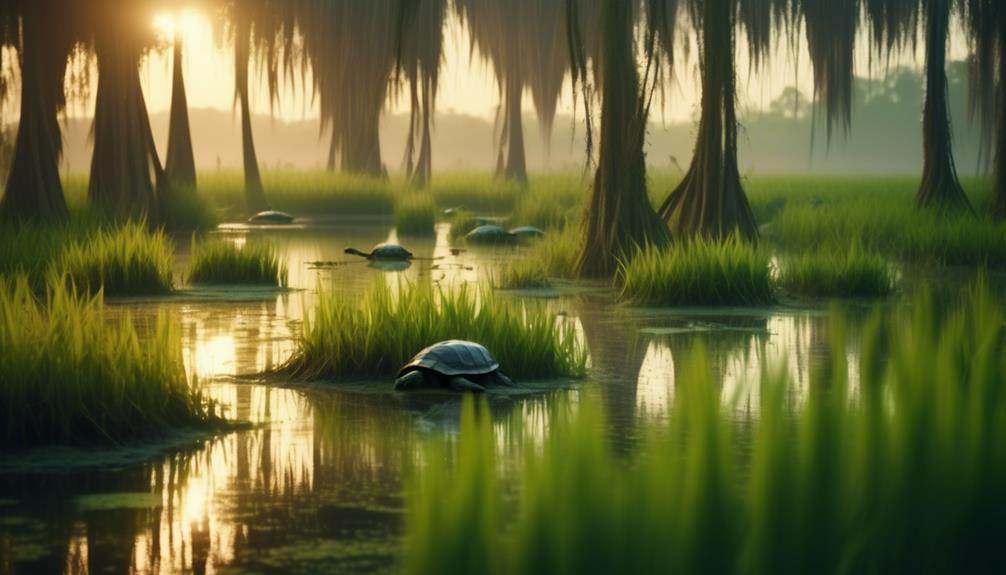
Mud Turtles thrive in various aquatic habitats, making them adaptable and versatile creatures. These turtles can be found in ponds and bodies of water, with or without vegetation. However, they prefer ponds that have abundant vegetation.
Mud Turtles can also be found in spring-fed streams, as they prefer clean and oxygenated water. Their native habitat includes sandy and muddy areas that provide them with suitable conditions for hibernation.
These turtles have the ability to thrive in different types of environments, showcasing their ability to adapt to their surroundings. Whether it’s a pond with lush vegetation or a spring-fed stream, Mud Turtles have the flexibility to make these habitats their home.
Preferred Water Conditions for Mud Turtles
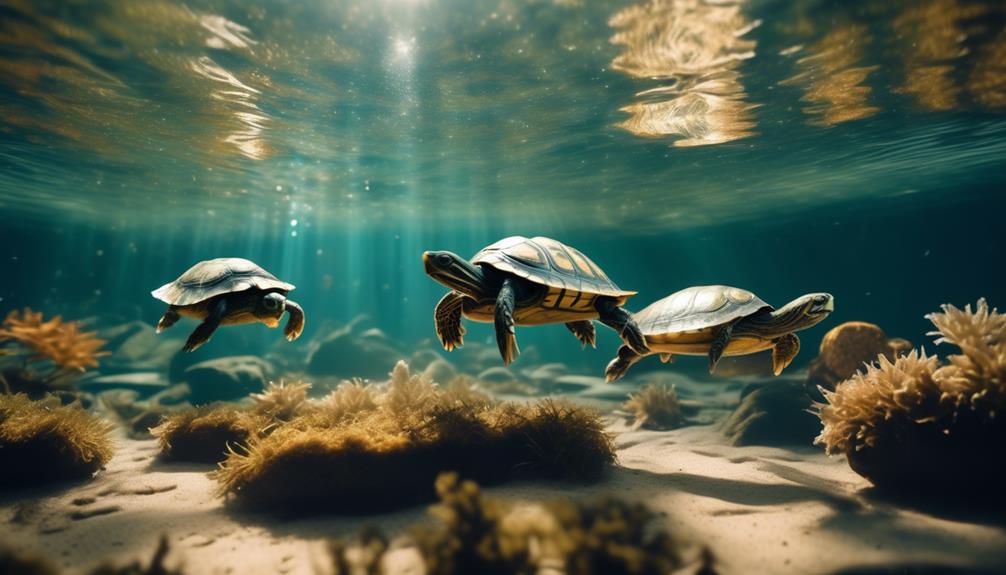
To ensure the health and well-being of your Mud Turtles, it’s essential to create and maintain optimal water conditions in their enclosure. Here are four key factors to consider when providing water for your Mud Turtles:
- Temperature: Mud Turtles thrive in water temperatures between 70-75°F. Keeping the water within this range will ensure their comfort and overall health.
- Cleanliness: Mud Turtles prefer clean, oxygenated water. Regularly monitor and maintain the water quality by using a filtration system and performing regular water changes.
- Depth: Provide a water depth that allows your Mud Turtles to fully submerge and swim comfortably. A depth of around 8-10 inches is suitable for most Mud Turtle species.
- Vegetation: Mud Turtles prefer ponds with abundant vegetation. Adding live or artificial plants to the enclosure won’t only create a natural aesthetic but also provide hiding spots and stimulate their natural behavior.
Hibernation Habits of Mud Turtles
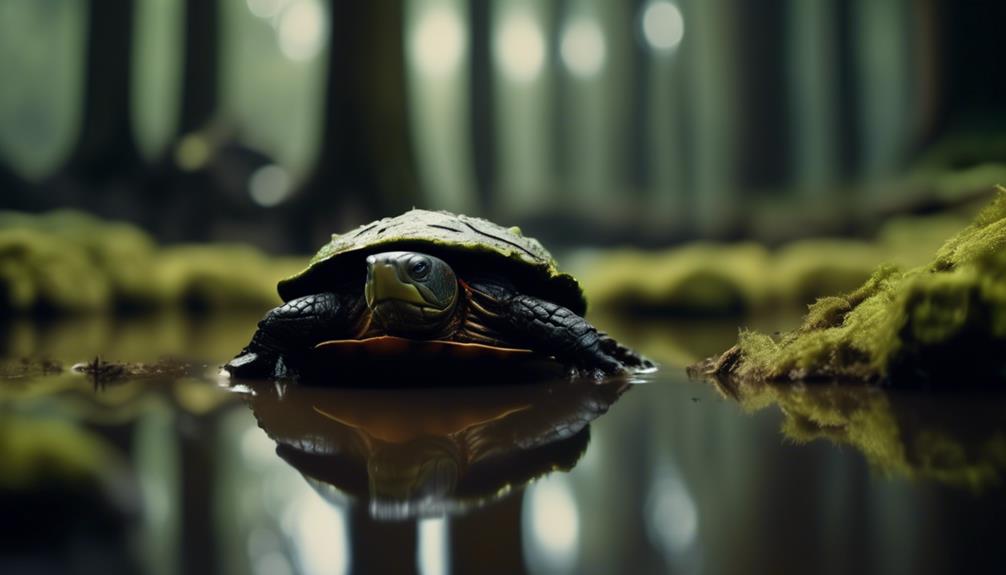
During the winter months, Mud Turtles have specific hibernation habits that ensure their survival and well-being. When the temperatures start to drop, these turtles seek out suitable hibernation sites. They prefer sandy or muddy areas where they can bury themselves and remain hidden from predators.
Mud Turtles are ectothermic, which means their body temperature is dependent on the surrounding environment. As the temperatures continue to decrease, their metabolic rate slows down, allowing them to conserve energy. During hibernation, Mud Turtles can survive for several months without eating. They rely on stored fat reserves to sustain them during this dormant period.
It’s crucial to provide a suitable hibernation environment in captivity to mimic their natural hibernation habits and ensure their overall health and well-being.
Setting Up the Ideal Environment for Mud Turtles
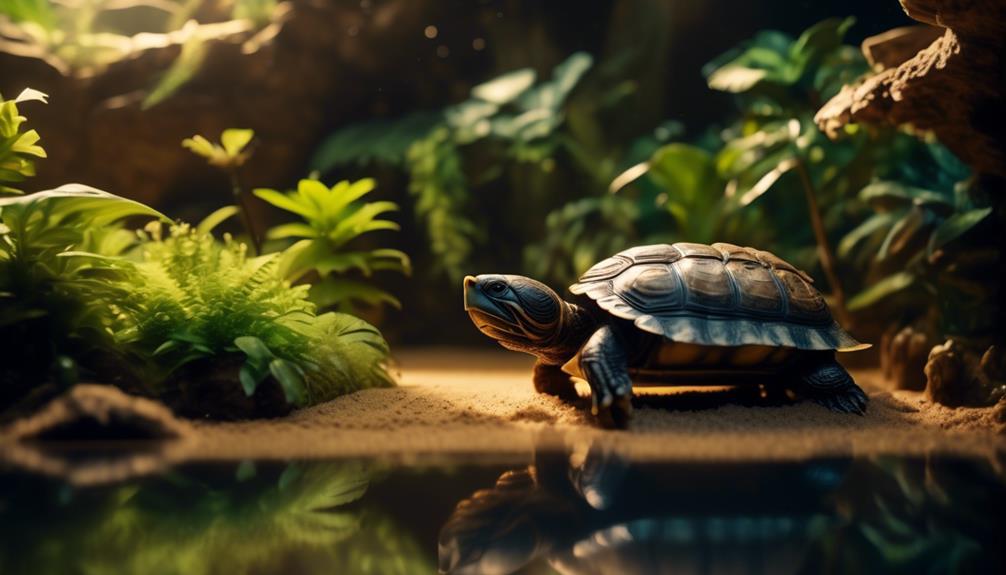
Creating the perfect environment for your Mud Turtles involves careful attention to temperature, lighting, and habitat setup. To ensure the well-being and happiness of your Mud Turtles, here are four crucial elements to consider:
- Temperature: Maintaining the right temperature in their enclosure is vital. Mud Turtles need a basking area with a heat lamp set to around 90°F for proper digestion and thermoregulation. The rest of the enclosure should be kept at a temperature of 80-85°F, while the water temperature should be maintained at 70-75°F.
- Lighting: Providing a UVB light for half of the day is crucial for Mud Turtles’ health. This helps them metabolize calcium and prevent shell deformities and other health issues.
- Habitat setup: Creating a suitable habitat involves using gravel as substrate, which mimics their natural environment. Also, ensure that there’s enough water depth for swimming and a dry area for basking.
- Clean and safe water: Mud Turtles prefer clean, oxygenated water. Regularly clean and maintain their water to prevent the buildup of harmful bacteria or toxins.
Tank Size and Temperature Requirements for Mud Turtles
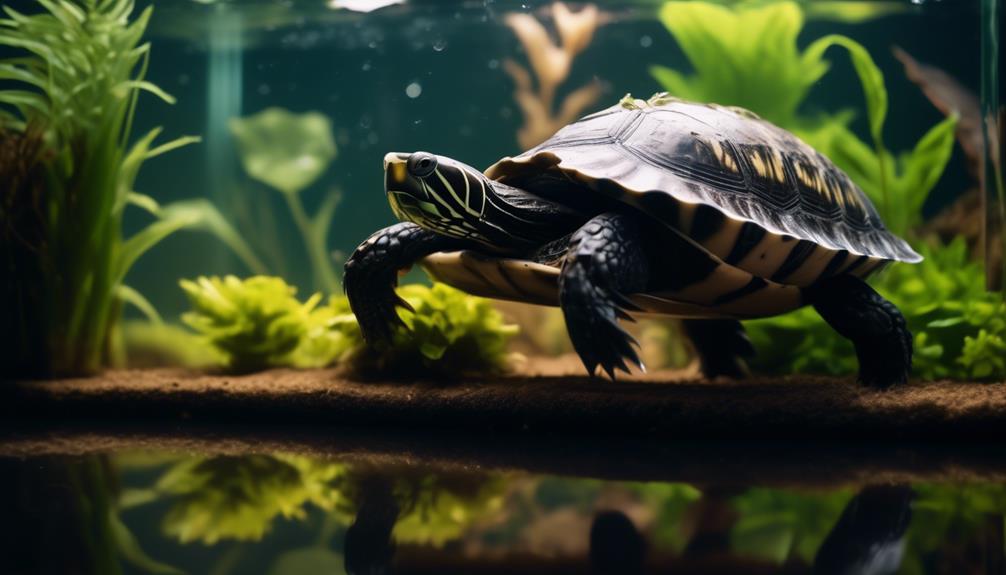
When caring for Mud Turtles, it’s important to consider the appropriate tank size and temperature requirements. Mud Turtles require a minimum tank size of 40 gallons for one or two turtles. This allows them enough space to swim and move around comfortably.
In terms of temperature, it’s crucial to provide a basking area with a heat lamp set to around 90°F. The rest of the enclosure should be maintained at a temperature of 80-85°F. Additionally, the water temperature should be kept at 70-75°F.
To create a suitable environment for Mud Turtles, it’s recommended to use gravel as substrate and provide a UVB light for half of the day.
Substrate and Lighting for Mud Turtles
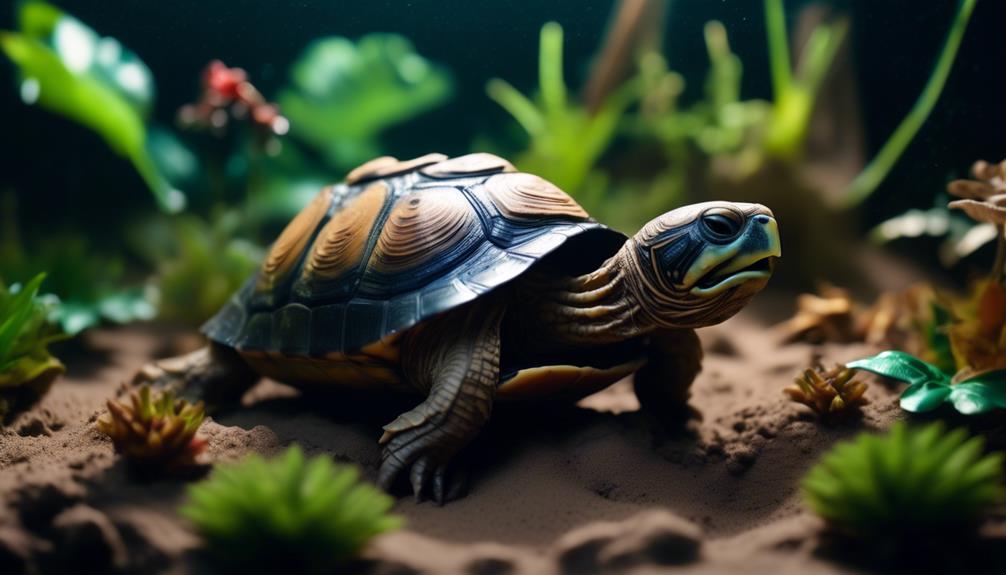
To properly care for your Mud Turtles, it’s essential to understand the importance of substrate and lighting in their habitat. Here are four key factors to consider:
- Substrate: Choose gravel as the substrate for your Mud Turtle’s tank. This will provide a natural feel and allow for easy burrowing. Watching your turtle dig and explore in the gravel can be a fascinating and rewarding experience.
- Lighting: A UVB light is crucial for your Mud Turtle’s health and well-being. It helps them metabolize calcium and promotes proper shell growth. Seeing your turtle basking under the warm glow of the UVB light can be a visually pleasing sight.
- Heat Lamp: Provide a basking area with a heat lamp set to around 90°F. This mimics the natural sun exposure that Mud Turtles require for thermoregulation. Seeing your turtle relax and soak up the warmth can be a comforting sight.
- Day and Night Cycle: Ensure your Mud Turtle has a consistent day and night cycle by using a timer for the lights. This helps regulate their internal clock and promotes natural behavior. Witnessing your turtle thriving in a well-regulated environment can be immensely satisfying.
Mud Turtle Diet: What to Feed Them
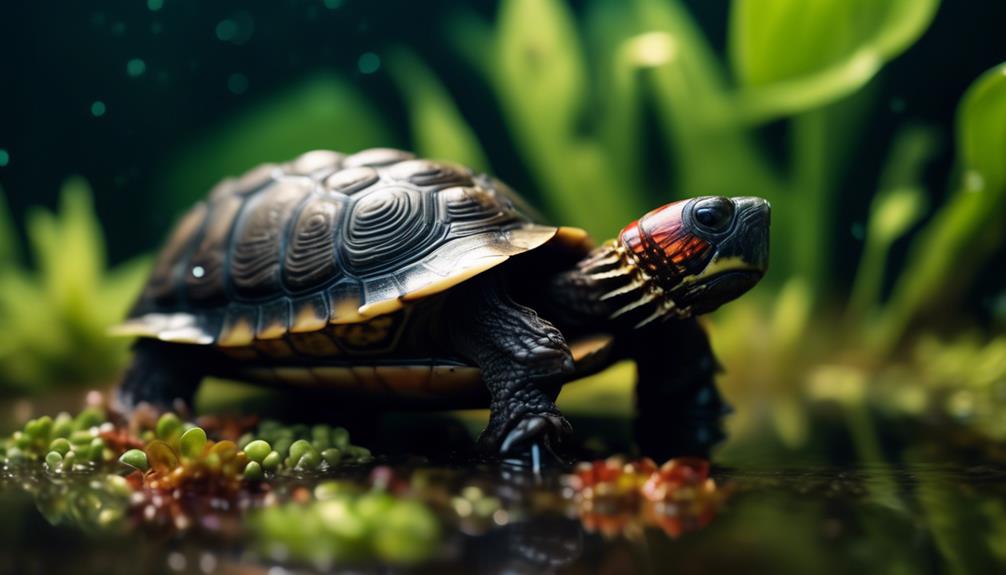
Feeding your Mud Turtle a balanced diet is crucial for their overall health and well-being. These omnivorous creatures have a varied appetite, and their diet should consist of a combination of commercial pelleted turtle diet and supplements.
In addition to this, it’s important to include a variety of natural food sources such as snails, insects, fish, worms, and dark leafy greens. Providing a diverse diet ensures that your Mud Turtle receives all the essential nutrients it needs to thrive.
Remember to avoid overfeeding and monitor their weight to prevent obesity.
It’s also important to note that Mud Turtles can be kept in a community tank with other Mud Turtles and Musk Turtles, but handle them only when necessary as they can bite and release a foul-smelling fluid when stressed.
Behavior and Handling of Mud Turtles
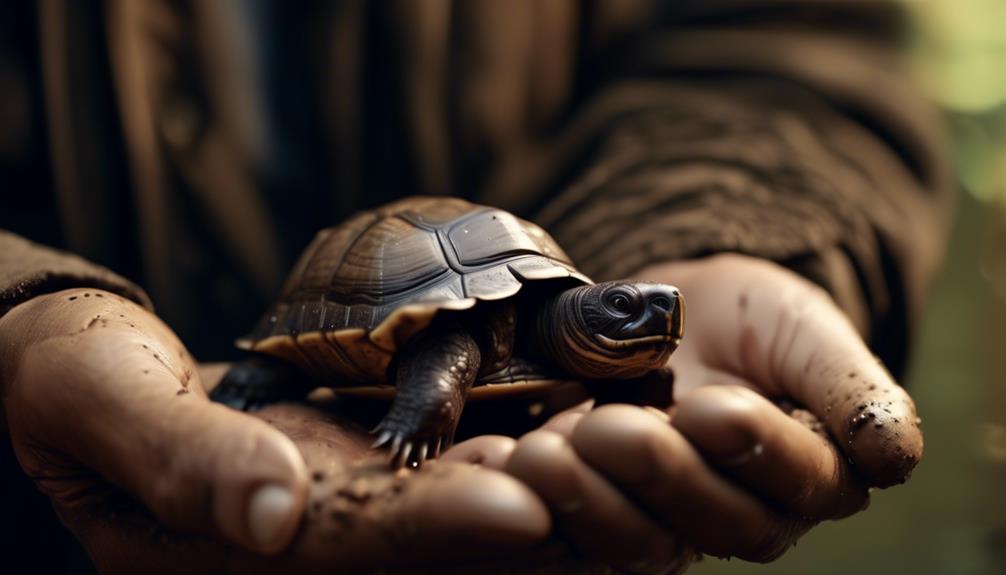
Mud Turtles exhibit distinct behaviors and require careful handling to ensure their well-being. Here are four important things to know about their behavior and handling:
- Shy and Timid Nature: Mud Turtles are known to be shy and timid creatures. They may retreat into their shells when approached or feel threatened. It’s important to handle them gently and provide a calm and quiet environment to make them feel safe.
- Biting Tendency: Mud Turtles have strong jaws and can bite when they feel threatened or stressed. It’s crucial to handle them with caution, avoiding any sudden movements or actions that may provoke them. Always approach them from the side or behind to reduce the risk of being bitten.
- Foul-Smelling Defense Mechanism: When handled or stressed, Mud Turtles have the ability to release a foul-smelling fluid from the glands on the sides of their body. This is their defense mechanism to deter predators. It’s essential to handle them minimally and with care to avoid triggering this response.
- Proper Support and Grip: When handling Mud Turtles, it’s important to support their body properly and provide a secure grip. Avoid holding them by their limbs or tail, as this can cause injury. Instead, gently hold them with both hands, supporting their shell and body weight to ensure they feel secure and comfortable.
Frequently Asked Questions
Can Mud Turtles Live in Aquariums or Do They Need a Natural Pond Environment?
Mud turtles can live in aquariums, but they require specific care. Provide a minimum tank size of 40 gallons, a basking area with a heat lamp, and maintain water and enclosure temperatures.
Are Mud Turtles Compatible With Other Turtle Species in a Community Tank?
Yes, Mud Turtles can be kept in a community tank with other turtle species like Musk Turtles. However, it’s important to handle them only when necessary as they can bite and release a foul-smelling fluid when stressed.
How Often Should Mud Turtles Be Handled?
You should handle mud turtles only when necessary, as they can bite and cause harm. They can release a foul-smelling fluid when stressed. It’s best to give them their space and minimize handling.
Do Mud Turtles Require Any Special Care During Hibernation?
During hibernation, mud turtles do require special care. Make sure to provide them with sandy or muddy areas for hibernation. Maintain the water temperature at around 70-75°F and keep the tank temperature cool.
How Often Should the Water in a Mud Turtle’s Tank Be Cleaned and Changed?
You should clean and change the water in your mud turtle’s tank at least once a week. This helps maintain a clean and healthy environment for your turtle.
How Do Three-Toed Box Turtles Compare to Other Mysterious Mud Turtles?
When it comes to rare turtle species revealed, the Three-Toed Box Turtle stands out for its unique combination of characteristics. While mysterious mud turtles may have their own enigmatic qualities, the Three-Toed Box Turtle’s distinct three-toe feature and terrestrial lifestyle set it apart from other rare turtle species.
Conclusion
In conclusion, exploring the mysterious world of mud turtles has revealed fascinating insights into their size, appearance, and native habitats.
From their unique shell characteristics and distinctive features to their diverse range of colors and patterns, mud turtles are truly captivating creatures.
By understanding their tank size, temperature requirements, and suitable diets, we can create the perfect environment to care for these enchanting turtles.
So, grab your snorkel and dive into the world of mud turtles to uncover their secrets.

